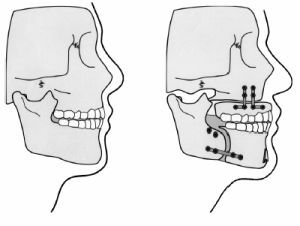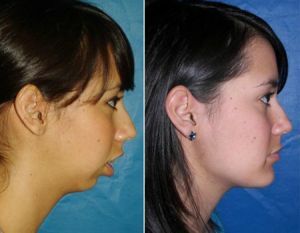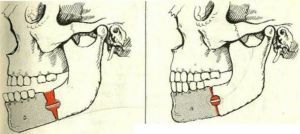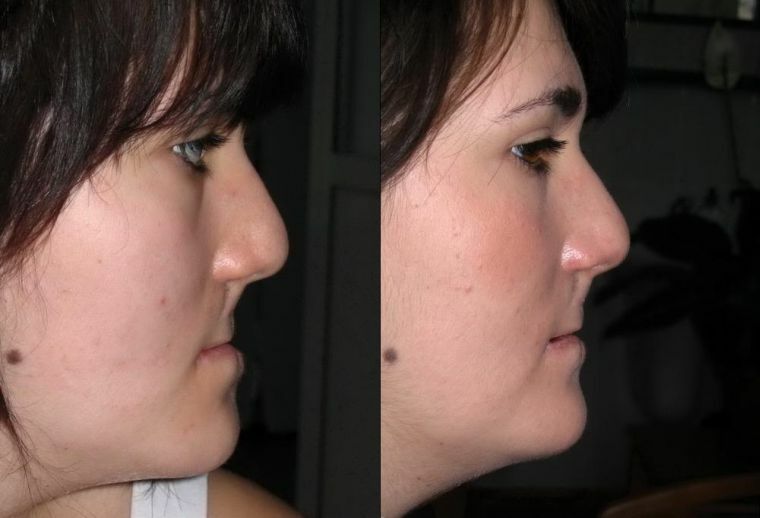 There are bite defects that can not be fixed without the intervention of an experienced surgeon. It also happens that only after the operation, the person's face finally acquires an attractive appearance, and the dentoalveolar system begins to function correctly and fully.
There are bite defects that can not be fixed without the intervention of an experienced surgeon. It also happens that only after the operation, the person's face finally acquires an attractive appearance, and the dentoalveolar system begins to function correctly and fully.
Today in medical practice such procedure as osteotomy of the lower jaw is in demand, in some situations it is done also on the upper jaw, but much less often.
This article will describe in detail what exactly this operation represents.
Contents of
- What is the role of osteotomy in dental practice?
- Indications and contraindications for intervention
- Preparation for operation
- Intervention
- On mandibular
- On upper jaw
- Expected effect
- Rehabilitation period
- Price
What is the role of osteotomy in dental practice
Osteotomy isThe type of operation that is performed on one of the patient's jaws, and in some cases immediately on both. Typically, an osteotomy is prescribed when there are serious bite pathologies, impaired development of the jaws, or in order to eliminate the results of an unsuccessful operation in the treatment of palatine clefts.
On the lower jaw, surgery is often performed after getting injured.
Types of osteotomy:
- fragmentary;
- general.
All the defects mentioned above largely disfigure the appearance of the person, which means that they turn into a source of permanent complexes and contribute to the development of serious illnesses, for example:
- respiratory function disorder;
- of the jaw joint disease;
- diseases of the digestive system.
For this reason, a timely corrective operation on the jaw can greatly improve the patient's quality of life.
Indications and contraindications for
intervention This operation is performed in the following cases:

In the photo, the face of the patient before and after the osteotomy of the jaw
- dislocation of the dentition, which can not be eliminated with orthodontic methods and designs;
- is an obvious facial disproportion, unbearable from an aesthetic point of view.
There are times when you can not conduct an osteotomy. Such an operation is never assigned to underage children, since they still have bone formation.
Other reasons for refusal to implement this intervention:
- lack of preparation of dentition;
- various infectious diseases;
- poor blood clotting;
- presence of diabetes.
It should be clearly realized that the main purpose of corrective osteotomy is to correct the position of the jaw and eliminate bone deformities.
She will not be able to change the original wrong position of the teeth. For this reason, before the appointment of an operation, the doctor can recommend alignment of the dentition with the help of braces, tooth extraction, prosthetics, correction of side strings and other procedures.
Preparing for operation
Before performing the operation, it is necessary to prepare the dentition. This is done by using braces or by prosthetics or implantation.
Surgical preparatory preventive interventions can also sometimes be performed:
- tooth extraction;
- crown exposure;
- correction of side strands and bridles and other procedures.
Intervention
Features of osteotomy depending on the operated jaw.
On the lower jaw
 The osteotomy of the lower jaw is carried out by intraoral access, which will not allow the formation of scars and scars on the skin of the face.
The osteotomy of the lower jaw is carried out by intraoral access, which will not allow the formation of scars and scars on the skin of the face.
The mucous membrane and the periosteum are cut in the projection of the pterygium-jaw fold, taking into account the transition to the external surface of the body of the lower jaw. The boundaries of the section are expanded, which facilitates the creation of comfortable access to the lower jaw.
A special saw the surgeon saws compact plates in the mandibular branch, after which its fragments are divided. Similar actions are performed on the second side.
After the bilateral osteotomy is completed, the jaw is placed in a predetermined position.
The final step is to fix the jaw fragments in the current position with special titanium fixatives and screws. 
Within a month after the intervention, there will be some swelling of the soft facial tissues. In addition, there may be a decrease in sensitivity in the field of intervention, which will disappear itself after a period of up to six months.
In some cases, in order to guarantee a successful outcome of the operation, the specialist performs splinting using miniplanes - the jaws are securely attached to each other, so the patient can not open his mouth too wide. At this time, he can only eat liquid or grated food.
On the upper jaw
For the use of endotracheal anesthesia. The mucous membrane of the oral cavity and the periosteum are cut slightly above the fold of the maxillary junction. The borders of the wound are moved apart for better access to the jaw.
On the front and side jaw walls on the left and right side are markings of the cut edges.
With the use of a special file, osteotomy is performed by marking.
The sawn fragment is separated and placed in a predetermined position. The fragment is fixed with a mini-plate made of titanium.
Possible complications:
- infection of the wound;
- displacement of fragments of bone tissue;
- too slow bone fusion;
- paresthesia - a decrease in the sensitivity of the skin in the area where the operation was performed.
Expected effect
After some time after the surgical intervention, when the rehabilitation period is over, patients note an obvious positive result.
- Nibble and chew food becomes easier , which affects the digestive system.
- Teeth less wear and tear , which is very common in the presence of bite defects.
- Improves the appearance of the patient - bite comes back to normal, the ratio of the jaws becomes harmonious, and the smile - beautiful. A person raises self-esteem, he becomes more confident.
- The likelihood of the temporomandibular joint disease is reduced, as the volume of exercise is reduced.
- If the problem is a result of an injury, operation will facilitate the return of the former appearance of .

Osteotomy is a very popular and demanded procedure due to its effectiveness.
Rehabilitation period
Although osteotomy of the jaw is a common operation, the rehabilitation period after it is quite complex and prolonged. Immediately after completion of the intervention, the patient is prescribed antibiotics to prevent infectious diseases. In addition, a tight bandage is applied, which can be removed only the day after the end of the operation.
The doctor installs special locks to fix the position of the jaws, after which he must follow both their location and the bite in general.
Until the latches are removed, the patient can not chew food, flaunt and open his mouth wide. Approximately two weeks after the operation, seams will be removed. The fixing screw will be removed by the specialist after three months. The next stage is orthodontic therapy.
Price issue
Jaw alignment is a complex operation and the price of osteotomy is considerable and depends on the following factors:
- the status of the medical institution;
- qualification of specialists;
- the complexity of the disease;
- is a form of intervention;
- work area, that is, whether the operation is only on one jaw, or on both.
Approximate cost of the operation - from 20 to 60 thousand rubles.
